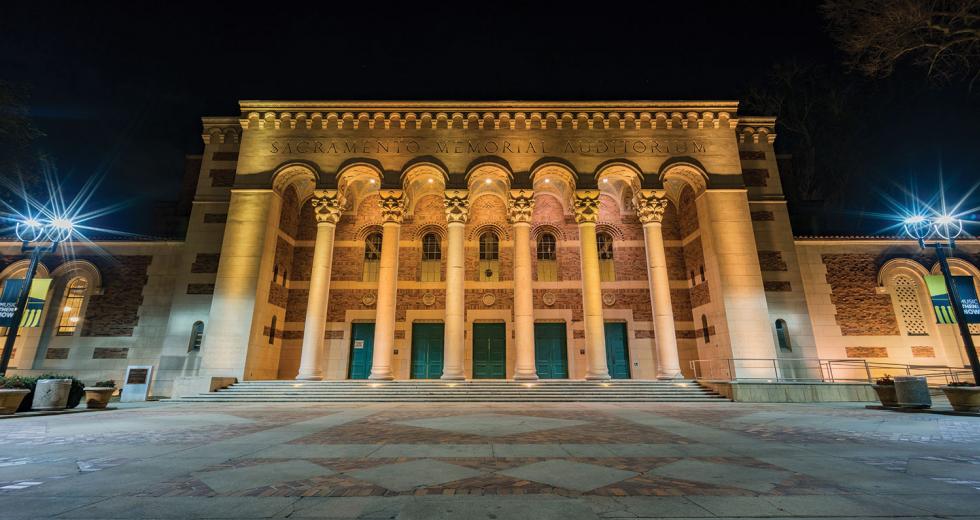While no one can claim that George Washington slept there, we can definitely verify that Keith Richards of the Rolling Stones was nearly electrocuted there. It’s been the venue for many rock concerts, weddings, dances and trade shows, the graduation of thousands of high school and law school students, and its share of governmental state-of-whatever addresses.
And while it’s safe to say the Sacramento Memorial Auditorium was built for a noble purpose — a dedication to those who had served the country — it was also to help Sacramento attract convention trade. And it’s also not a stretch to say that if it hadn’t been for Sacramento Memorial Auditorium, there might never have been a Golden 1 Center.
The Memorial, as it’s been affectionately referred to since it opened in 1927, is the 93-year-old crown jewel of the California capital’s SAFE Credit Union Convention and Performing Arts District, which also includes — excuse its dust — the Community Center Theater and a massive conference enclave under renovation. Within the auditorium itself is even a mini-Memorial: the Jean Runyon Little Theater, named in honor (and in the lifetime) of the region’s premier public relations maven, who supported every lively art she encountered, though it was the stage that nurtured her.
In its 93 years, Sacramento Memorial Auditorium has held many
events, including this banquet in 1961. (Photo courtesy of Center
for Sacramento History)
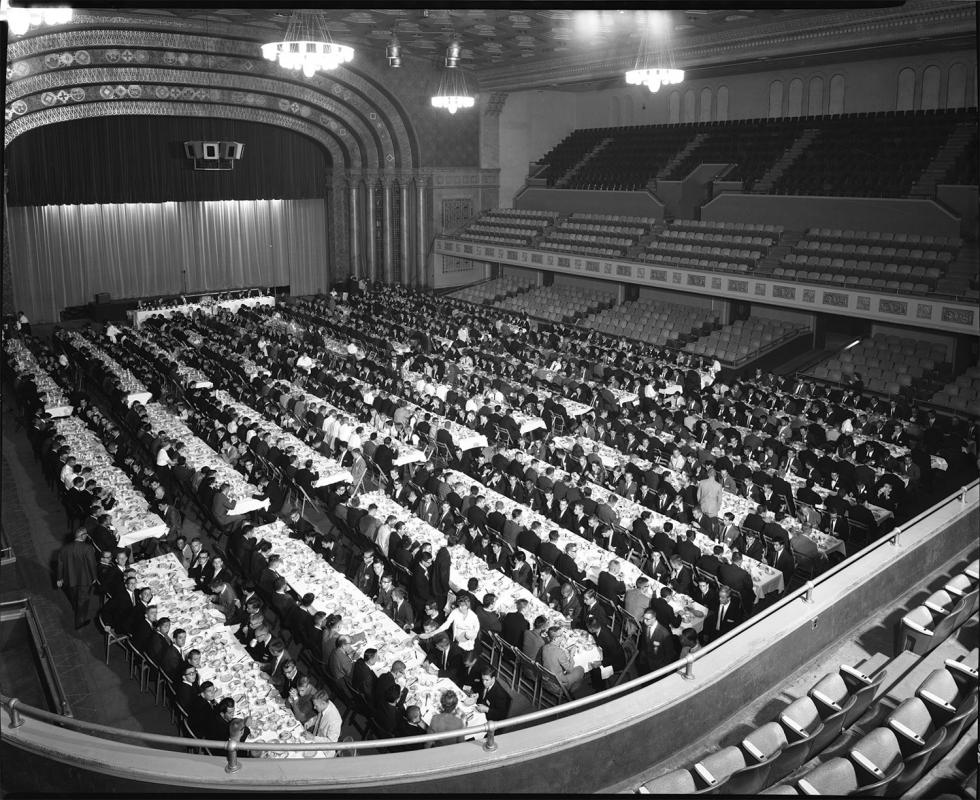
While chronologically a relic, the Memorial is anything but a fossil. Its tiltable stage floor, for example, which descends to allow another portion of the surface to function as an elevated platform, was seen as a modern marvel not only during its construction, which began in 1925, but also as recently as three years ago when an epic updating of the facility began, mostly to accommodate requirements of the Americans with Disabilities Act.
“All of the building’s mechanisms, first installed 90 years ago, still worked beautifully,” Jeff Davis, a senior principal at Architectural Nexus, told me nearly three years ago for a story about the $16.1 million renovation, which included an upgrade of the venue’s electrical and lighting systems and its acoustics to allow traveling Broadway shows to be performed there while the SAFE Credit Union Performing Arts Center was undergoing its rebirth.
One of the more interesting aspects about the Memorial’s history is that while its ostensible purpose was to build a functioning monument to those Americans who had lost their lives fighting in wars past (and wars to come), it was primarily built as a major sortie in Sacramento’s seemingly eternal battle to emerge from the shadow of the Bay Area.
“The general secretary of the Chamber of Commerce in 1916, Henry S. Maddox, wanted to make Sacramento a convention city and needed an auditorium to make that happen,” says Marcia Eymann, the City of Sacramento’s historian. In addition to being built to promote conferences and trade shows, Eymann says, the facility would provide a venue for cultural and sports events. “This meant a lot to the community to (be able) to see opera, theater and musical performances that only went to larger cities with larger stage potential. It was another effort to keep up with San Francisco.”
There were other elements of progressive thinking that went into building the Memorial — among them the issuing of municipal bonds. These tax-free funding devices are still employed ubiquitously (and certainly here in Sacramento) but had actually been around for a century before the Memorial was financed. (If your inner fiscal nerd demands to know, New York City issued the first recorded municipal general-obligation bond to build a canal in 1812.)
Carson Anderson, Sacramento’s director of preservation since 2016 and a senior planner for the city, says the design of the building’s exterior was not quite as all-American as the facility’s expressed patriotic purpose would suggest.
“The Memorial is a prime example of Northern Italian architecture of the late 1920s,” he says, a hybrid of “Lombardic-Romanesque design with Byzantine elements.” Architect Arthur Brown Jr., best known for his designs of city halls for San Francisco and Pasadena, worked on the Memorial, Anderson says. (If your inner history nerd would enjoy learning more, Brown’s dad, Arthur Brown Sr., had been an engineer for Central Pacific Railroad in the 1860s when the transcontinental railroad was finalized.)
If you note a seeming discrepancy between the initial 1916 spark of building Memorial Auditorium and the fact that it took 11 more years for its final I beams to be dotted and T-nuts to be crossed, historian Eymann offers some surprisingly contemporary perspective on that.
“Though the public liked the idea, city government was slow to act,” she says. “In 1921, City Councilman H.W. Funke brought up the building of the auditorium to the city council, and a committee was appointed to look into the project.” It apparently took the rhetoric of Clyde Seavey, Sacramento’s city manager at the time, to tell the hesitating council in 1921 that “as the capital of the State, and … the center of the State, Sacramento should have many large conventions and meetings which are not coming here because we have no auditorium for a meeting place,” according to “Sacramento Memorial Auditorium: Seven Decades of Memories,” by Bonnie Wehle Snyder and Paula J. Boghosian. Seavey told The Sacramento Bee that “the need for the auditorium is primarily a need of the Sacramento people themselves.”
Any comparison between that argument and everything that went into the Golden 1 Center finally opening in 2016 after years of uncertainty and lack of political will is purely coincidental. And, someday, is sure to be historic too.
–
Tell us what you want to see in Comstock’s: Take our reader feedback survey and be entered to win a $100 gift card.
Recommended For You
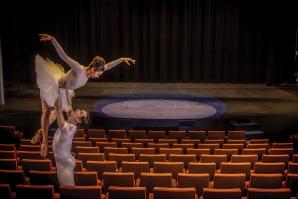
Out of the Spotlight
The coronavirus pandemic has closed the curtain on the Capital Region’s performing arts, but leaders are hopeful about the future
Last year was a strong one for the performing arts in the region, and 2020 was building on that success, which has led to hope from some local arts leaders that this progress will continue despite the unprecedented shutdown.
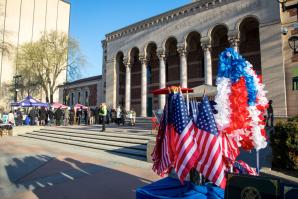
Journey to Citizenship
After years of waiting, Khaleel Yasir and his wife, Zuhal Al Ameen, became naturalized U.S. citizens on Feb. 22 at the Sacramento Memorial Auditorium. During the monthly naturalization ceremony, 1,060 residents from 81 countries took the oath of citizenship. Yasir resettled his family to Sacramento in 2012 after nine years of service as an interpreter for the U.S. military in Iraq.
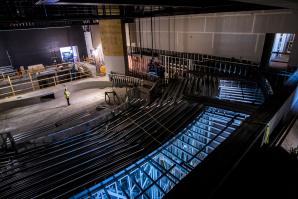
A Sense of Place
Sacramento designers and architects challenge the notion that outside talent is more suitable for notable projects
Sacramento is coming into its own, and tying the built environment to the regional diversity — including an agricultural backdrop and focus on sustainability — is important to local designers and architects.



